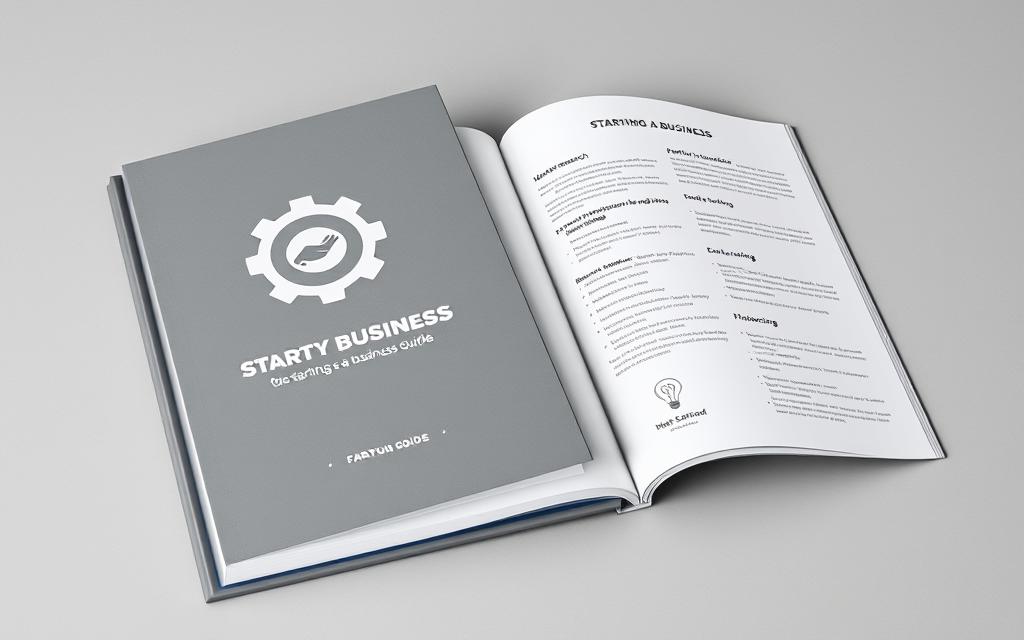Embarking on an entrepreneurial journey demands strategic preparation and a clear roadmap. Many ventures falter due to inadequate planning or unrealistic expectations, making systematic approaches vital. Breaking the process into actionable phases helps transform ideas into sustainable operations.
The Small Business Administration’s 10-step framework offers practical insights for aspiring entrepreneurs. From market research to legal registration, each phase builds towards establishing a resilient enterprise. Understanding tax obligations and employment laws early prevents costly oversights later.
Successful ventures often share common traits: thorough risk assessment, adaptable strategies, and robust financial planning. Contrary to popular belief, innovation alone rarely guarantees success. Consistent execution and compliance with regulations prove equally critical.
This guide addresses fundamental challenges, from securing funding to managing growth sustainably. We’ll explore how cultivating resilience and forward-thinking separates thriving organisations from short-lived attempts. Practical advice will cover essential systems for tracking progress and adjusting tactics in dynamic markets.
Preparation remains the cornerstone of entrepreneurial achievement. By prioritising structured development over haste, founders lay groundwork for enduring success. Subsequent sections detail these principles, equipping readers with tools to navigate the complexities of modern commerce.
Understanding the Business Landscape
A clear grasp of market dynamics forms the bedrock of entrepreneurial success. Founders must articulate their core purpose while mapping industry challenges and opportunities. This dual focus creates alignment between vision and commercial realities.
Identifying Your Business Idea and Purpose
Every venture begins with a fundamental question: does it fulfil a personal ambition or address a marketplace gap? Glenn Gutek, CEO of Awake Consulting and Coaching, notes:
“Clarity on purpose determines whether ventures solve problems or simply exist.”
Aligning passion with customer demands increases relevance and resilience.
Assessing Market Needs and Competition
Thorough analysis separates viable concepts from wishful thinking. Effective strategies combine:
- Surveys and focus groups capturing customer preferences
- SEO data revealing search trends
- Competitor benchmarking highlighting industry standards
This approach identifies underserved niches and informs differentiation tactics. Quantitative metrics from public records and qualitative insights from pilot testing further validate concepts before full-scale launches.
Developing a Robust Business Plan
A well-structured business plan acts as both compass and communication tool. It translates vision into measurable targets while demonstrating viability to stakeholders. Effective plans balance ambition with evidence-based strategies.
Conducting Market Research and Analysis
Thorough market evaluation identifies opportunities and threats. Techniques include demographic segmentation, competitor service comparisons, and predictive analytics. Primary data from surveys complements secondary sources like industry reports.
Mapping customer behaviour patterns reveals unmet needs. For instance, analysing search trends might expose underserved demographics. This intelligence shapes unique value propositions.
Establishing Financial Projections and Break-Even Analysis
Financial modelling converts assumptions into numerical forecasts. The break-even formula—fixed costs divided by (price minus variable costs)—determines viability thresholds. Conservative estimates help anticipate cash flow challenges.
Sensitivity analyses test how variables affect profitability. Scenario planning prepares for market shifts. Clear charts and tables enhance credibility when presenting to lenders.
Choosing the Right Business Structure
Selecting an appropriate legal framework ranks among the most impactful decisions for new ventures. This choice governs operational flexibility, financial responsibilities, and legal protections. Founders must balance immediate needs with long-term ambitions when evaluating options.
Comparing Sole Proprietorship, Partnership, LLC and Corporation
Four primary business structures dominate commercial landscapes:
| Structure | Liability | Tax Treatment | Setup Complexity |
|---|---|---|---|
| Sole Proprietorship | Unlimited personal liability | Pass-through taxation | Simplest |
| Partnership | Shared personal liability | Pass-through taxation | Moderate |
| LLC | Limited liability | Flexible options | Moderate |
| Corporation | No personal liability | Double taxation* | Most complex |
*C-Corporations face corporate and shareholder taxes. S-Corporations avoid double taxation.
Understanding Personal Liability and Tax Implications
Personal liability exposure varies dramatically between structures. Sole proprietors risk personal assets for business debts, while corporations separate private wealth from commercial obligations. Legal expert Deryck Jordan emphasises:
“Corporate frameworks suit ventures targeting public listings or venture capital.”
Tax considerations prove equally critical. LLCs and partnerships offer pass-through taxation, avoiding corporate levies. Corporations pay taxes at entity level before distributing profits. State-specific regulations further influence optimal choices, requiring location-based analysis.
Registering Your Business and Acquiring Licences
Legal formalities lay the groundwork for operational legitimacy and market credibility. Proper registration secures your venture’s identity while meeting jurisdictional requirements. This process varies by location and industry, demanding careful attention to detail.
Reserving a Business Name and Registering Your Entity
Selecting a viable business name involves three critical steps:
- Conducting trademark searches through USPTO databases
- Verifying domain name availability for digital presence
- Filing reservation documents with your state authority
Most states allow 30-day holds on reserved names while completing entity formation. Registration with the Secretary of State becomes mandatory for LLCs and corporations. Fees range from $50 to $500 depending on jurisdiction.
Obtaining an Employer Identification Number and Other Documents
The federal employer identification number (EIN) serves as your venture’s tax identifier. Apply directly through the IRS website without charges. This identification number proves essential for:
- Opening commercial bank accounts
- Hiring employees legally
- Filing annual tax returns
| Document Type | Purpose | Issuing Authority |
|---|---|---|
| EIN Confirmation | Tax reporting | Internal Revenue Service |
| Business Licence | Operational compliance | Local government |
| Professional Permit | Industry authorisation | State regulatory boards |
Certain industries require specialised licences or permits. Restaurants need health certifications, while contractors demand trade-specific approvals. Consult business licence registration guidelines for sector-specific rules.
Securing Funding and Managing Finances
Financial foundations determine a venture’s capacity to scale and adapt in competitive markets. Strategic allocation of resources requires understanding diverse capital sources and their long-term implications. Founders must balance immediate needs with sustainable growth targets.
Exploring Capital Acquisition Strategies
Four primary funding options dominate early-stage ventures:
| Source | Requirements | Best For |
|---|---|---|
| Bank Loans | Credit score + collateral | Established credit histories |
| SBA Programmes | Business plan + eligibility | Underrepresented founders |
| Angel Investors | Equity stake | High-growth potential |
| Crowdfunding | Compelling pitch | Consumer-focused products |
Marcus Anwar, Co-Founder of Oh My Craft, advises:
“Community banks often offer more flexible terms than national institutions. Their local market knowledge proves invaluable during financial negotiations.”
Building Financial Infrastructure
Separate business accounts safeguard personal assets while simplifying tax reporting. Essential steps include:
- Comparing fee structures across banking partners
- Implementing accounting software for real-time tracking
- Developing 90-day cash flow projections
Weekly reviews of accounts receivable and payable prevent liquidity crises. Automating invoice reminders and supplier payments maintains healthy working capital ratios.
Complying with Taxes and Government Regulations
Regulatory adherence forms the backbone of sustainable operations, protecting ventures from penalties and operational disruptions. Proactive management of fiscal responsibilities ensures alignment with evolving legislation while safeguarding financial stability.
Understanding Tax Requirements and Business Insurance
Tax obligations vary significantly between entities. Sole proprietors report income through personal returns, while corporations file separate returns. Quarterly estimated payments apply to businesses with substantial tax liabilities. Employment taxes require meticulous tracking, including Social Security contributions and withheld income taxes.
Insurance needs differ by industry and location. General liability coverage protects against third-party claims, while professional indemnity insurance suits service providers. States like Georgia mandate specific policies:
- Workers’ compensation for firms with ≥3 employees
- Automobile liability insurance for company vehicles
“Underestimating insurance needs risks catastrophic financial exposure. Annual policy reviews prevent coverage gaps as operations evolve.”
Meeting Licence, Permit and Registration Obligations
Compliance extends beyond initial registrations. Many industries require ongoing renewals:
| Requirement | Frequency | Governing Body |
|---|---|---|
| Health permits | Annual | Local councils |
| Alcohol licences | Biennial | State authorities |
| Professional certifications | Triennial | Industry boards |
Federal permits apply to sectors like aviation and agriculture. Municipal zoning approvals often dictate operational locations. The Small Business Administration maintains updated databases for sector-specific requirements.
Tip: Implement digital tracking systems for renewal deadlines. Partnering with compliance specialists reduces administrative burdens while ensuring adherence to all government mandates.
Practical Steps on how to start of business with a Professional Approach
Establishing credibility in competitive markets demands structured support systems. Government initiatives and private sector programmes offer vital scaffolding for small business development. Strategic alliances with experienced professionals accelerate decision-making while mitigating operational risks.
Leveraging Expert Guidance
The Small Business Administration connects owners with local partners through:
- Free counselling sessions addressing financial planning
- Mentorship schemes via SCORE’s 10,000+ volunteer advisors
- State-specific resources for licence applications
Seasoned consultant Margaret Rowe observes:
“New ventures accessing SBA training programmes achieve profitability 34% faster than those operating independently.”
Safeguarding Commercial Interests
Protecting intellectual property and implementing risk frameworks prove essential when scaling operations. Practical measures include:
- Registering trademarks through USPTO portals
- Developing disaster recovery blueprints
- Adopting CRM systems for customer retention
Regular audits of supplier contracts and employment policies maintain compliance as ventures expand. Participating in industry associations provides networking opportunities while keeping pace with regulatory changes.
For tailored support, contact the SBA at 1-800-827-5722 or explore their partners directory online. Proactive engagement with these resources positions new business ventures for sustainable growth.
Conclusion
Launching a sustainable enterprise demands more than initial enthusiasm. The systematic approach outlined in this guide highlights critical junctions every founder must navigate. From selecting a legal structure to securing appropriate loans, each decision shapes long-term viability.
New ventures thrive when combining thorough market analysis with adaptable strategies. Prioritise building relationships with customers while leveraging resources like mentorship programmes. Remember, registration formalities and compliance frameworks form just the foundation.
Successful business owners treat their initial plan as a living document. Regular reviews of financial models and industry trends enable proactive adjustments. Explore funding options early, but balance growth ambitions with realistic cash flow projections.
This guide serves as your roadmap through complex commercial landscapes. While challenges will arise, meticulous preparation and continuous learning position ventures for enduring success. The journey begins now – equipped with knowledge, persistence, and the right tools.
















